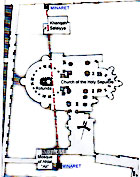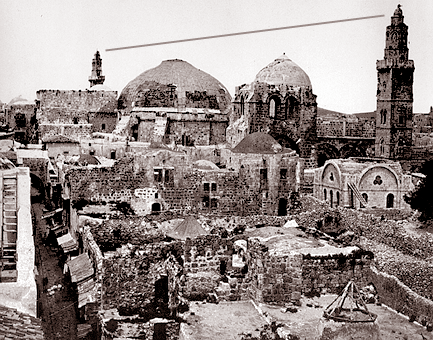The obsession with Jerusalem
has produced such a large number of books and articles that J. Purvis
decided to publish a bibliography (Jerusalem, The Holy City, 1988). The
book contains almost 5000 titles and references, but surely at least five
thousand more have been written since its compilation. Reading Purvis's
book, one realizes how meticulously each building and stone in Jerusalem
have been studied, and some of the conclusions or interpretations are
often interesting and peculiar. A good example is an article by Archibald
G. Walls that was published in the seventies in a specialised review.
Walls opened his article with a question: Is there a religious element
in the two almost identical minarets standing at the north and south of
the Rotunda of the Church of the Holy Sepulchre, which seem to watch over
Jesus Christ's tomb? Walls noticed that the two minarets are not only
very similar in their form and architectural structure, but they were
built around the same time, in the Mameluk period: the first one in 1417
and the second one in 1465. 
The bases of the minarets are built
on two different topographical levels but their summits are the same height,
as if the builder of the second minaret had insured it would be as tall
as the first.
The Mystery of the two Minarets

Walls studied a planimetry of the
area and noticed that the imaginary line that unites the two summits of
the minarets runs right over the entrance of Jesus Christ's tomb and that
the median point of the line is only two metres away from it. Moreover,
this imaginary line lies on the Mecca – Jerusalem axis.
Walls wondered if all these discoveries were merely coincidental, or the
results of a precise religious and theological decision on the part of
the builders. He came to the conclusion that there is, in fact, a connection
between the Muslim buildings and the Holy Sepulchre; of all the traditional
places connected to Jesus Christ, the Holy Sepulchre is the only one the
Muslims do not accept.
According to the Muslim tradition, Jesus Christ was not crucified and
thus was alive when he ascended to Heaven. The Romans actually crucified
Judas Iscariot, who had received Jesus Christ's appearance.
(According to one of the ancient Christian sects from Syria, Simon of
Cyrene was crucified in Jesus Christ's place.)
Murphy O' Connor, author of one of the most important archaeological guides
of Jerusalem, suggested that the Muslims were not trying to "protect"
the Holy Sepulchre with the two Minarets, but to "annul" it, because,
according to their tradition, it cannot be Jesus Christ's tomb.
![]()